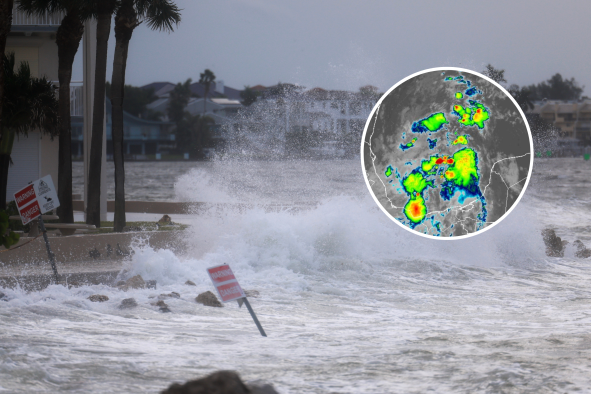A plume of solar plasma flung out from the surface of the sun might be about to spark auroras as far south as Illinois and Oregon.
The coronal mass ejection (CME) was released from sunspot AR3842 at the same time as an X7.1-class solar flare that triggered radio blackouts across Hawaii and the Pacific on October 2.
When the coronal mass ejection arrives some time on October 4, it's expected to trigger a G3 geomagnetic storm, possibly causing auroras to be seen across the northern U.S.
This strong geomagnetic storm is predicted despite the CME being relatively weak due to the Russell-McPherron effect, which occurs near the spring and fall equinoxes.
This occurs due to the Earth's magnetic field being tilted slightly, meaning that at certain times of year—late March and late September—it lines up in a way that makes it easier for solar wind and ejections to break through.
When the CME's magnetic field is pointing in the opposite direction of Earth's magnetic field, they connect more easily, letting more solar energy in, in a process called magnetic reconnection. As a result, more energy enters Earth's field, causing stronger geomagnetic storms than usual for a given CME.
"A CME is anticipated to reach and impact Earth with elevated geomagnetic response and dependent upon the orientation of the embedded magnetic field, potential exists for Strong Storm levels," NOAA's Space Weather Prediction Center said in an advisory.
"Limited, minor effects to some technological infrastructure possible, but mainly mitigatable. The aurora may become visible over many of the northern states and some of the lower Midwest to Oregon."
Geomagnetic storms' rankings are based on their intensity and potential effects, ranging from G1 (minor) to G5 (extreme). More powerful storms can cause stunning auroral displays visible closer to the equator than usual, as the solar plasma excites atoms of gas in Earth's atmosphere, producing the famously colorful light shows.
Geomagnetic storms can also affect satellites by causing increased drag, especially in low Earth orbit, as well as induce electric currents in power lines, potentially damaging transformers and other grid infrastructure.
"Flares can cause a radio blackout within about eight minutes of its occurrence on the sun, but a CME will take a day to a few days to reach the Earth. If a CME does impact the Earth, it can cause problems in communications and navigations systems and indeed cause problems with electrical power grid," Peter T. Gallagher, a professor of astronomy and astrophysics at the Dublin Institute for Advanced Studies in Ireland, told Newsweek.
The X7.1-flare that was associated with the coming CME was the second-most powerful flare of the solar cycle at the time, but on Thursday the sun released an X9.0 flare, which is now the strongest solar flare of Solar Cycle 25 so far.
A CME was also released at the same time, and is expected to arrive at Earth on October 6, potentially sparking more powerful geomagnetic storms.
Do you have a tip on a science story that Newsweek should be covering? Do you have a question about geomagnetic storms? Let us know via science@newsweek.com.
Disclaimer: The copyright of this article belongs to the original author. Reposting this article is solely for the purpose of information dissemination and does not constitute any investment advice. If there is any infringement, please contact us immediately. We will make corrections or deletions as necessary. Thank you.



